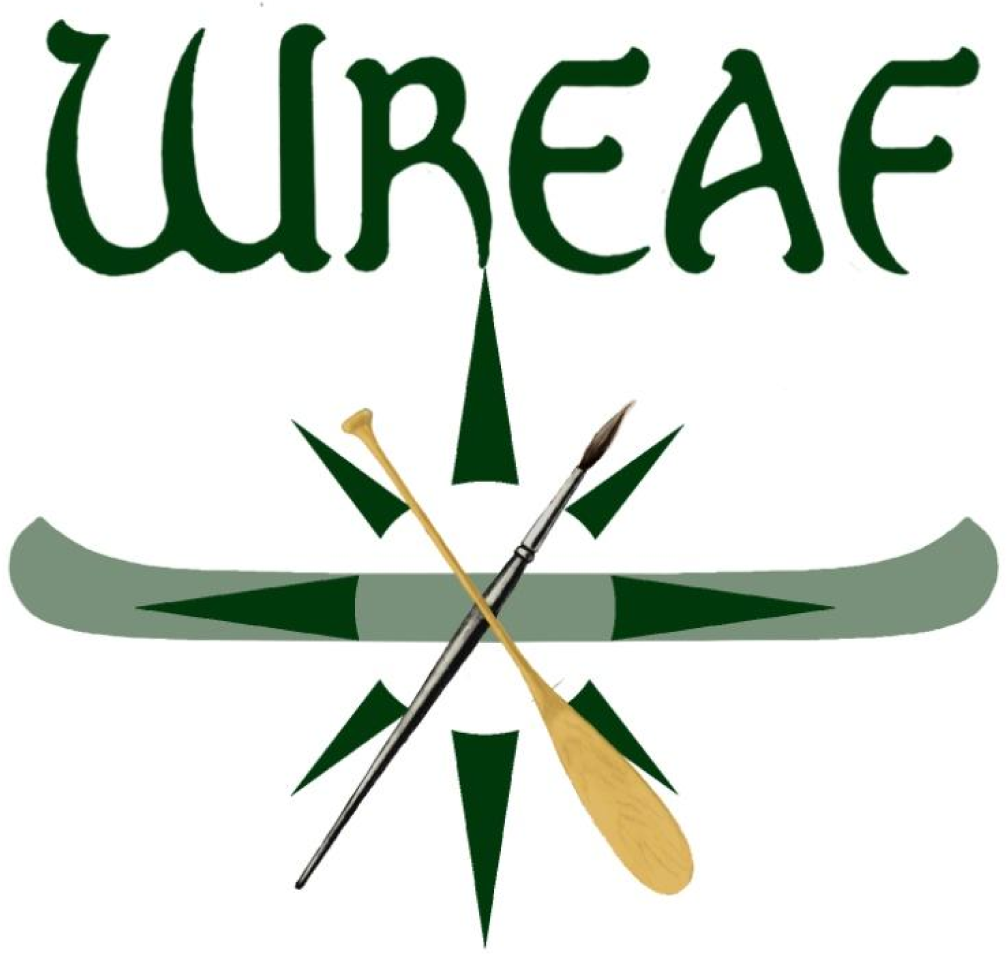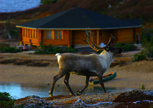

Lake Kamestatin, Labrador:
September 29-October 18, 2008
With the Smithsonian Institution's Arctic Studies Center
and the Innu Tshikapisk Foundation
Sponsored by the Canadian Wildlife Federation
Prepared by Rob Mullen, November 10, 2008; photos by Rob Mullen
In January of this year, with an introduction from Dr. Stephen Loring, I received an invitation from the Tshikapisk Foundation to send crews to their nascent eco-tourism facility at Lake Kamestastin for the spring and autumn Woodland Caribou migrations. On October 18 we returned to Montreal from our first expedition to this critical region for the George River caribou herd.
Lake Kamestastin sits in the bottom of a 38 million year old meteorite crater. That primordial cataclysm instantly exterminated the luxuriant sub-tropical Oligocene flora and fauna for many miles around yet ironically today is an island of diversity in the "Barrens". The ancient crater provides enough shelter from the near incessant wind to allow a large island of Boreal Forest to thrive along the south shore of the lake; the resulting food and shelter creating a wildlife magnet. For untold thousands of years the caribou herds of the Labrador/Quebec peninsula have funneled through on their way between the forest to the south and the lower predator density tundra for both the rut in autumn and calving in spring; and for thousands of years the Innu have awaited them at Lake Kamestastin.
September 30
The drive this day took us through yet another meteorite impact crater. If we had been there 212 million years earlier we'd have been obliterated by the impact as it left a crater 62 miles in diameter. The Manicouagan crater is now a reservoir created by the largest multiple arch and buttress dam in the world; the Manic 5 dam on the Manicouagan River. This was one of two major hydroelectric installations we saw on our drive. Hydro development is one of the major challenges facing the Boreal Forest. It also marked where we lost the paved road for most of the rest of the drive. Just before we stopped for the night we passed the mammoth iron mine just on the Quebec side of the border; another up close view of a major challenge facing the Boreal.
Building on our on-going work with Dr. Loring and Boreal Forest issues our goals were to:
• Intercept the George River caribou herd migration enabling the crew’s artists to spark public attention and
imagination regarding this key species
• Establish a working relationship with the Tshikapisk Foundation
• Explore the area in preparation for future work
• Strengthen WREAF’s exhibition proposal before the Smithsonian National Museum of Natural History
(NMNH) Outreach Advisory Committee (AOC formerly the Public Outreach Committee, POC)
• Rendezvous with Dr. Loring’s archaeological field team and Innu families
The first four goals of the expedition were met and surpassed. The rendezvous with Dr. Loring’s field team and Innu families at the encampment was short-circuited due to the vagaries of weather and caribou. Dr. Loring’s team had to abort their archaeological survey early due to prolonged high wind and associated issues and the Innu families we had expected to meet at the lake were still about 40 miles south of us at Border Beacon. Even so we met with Dr. Loring and a key member of his crew, Tony Jenkinson, co-founder of the Tshikapisk Foundation. Tony is one of the principals behind the effort to create the Innu eco-tourism facility at Lake Kamestastin and he joined us along with his 10-year old granddaughter for the duration of our stay. His wide-ranging expertise contributed enormously to all aspects of the expedition and the mutual respect and friendship that built during our two weeks at the lake will be invaluable in the future.
Our focus on Woodland Caribou flows from our work with Dr. Loring and the Arctic Studies Center. His more than thirty years of research in the area led him to suggest WREAF’s George River expeditions as part of developing our Smithsonian Boreal Forest exhibition proposal. Woodland Caribou are dependant on old-growth Boreal Forest and as such are a good indicator species: if they are doing well then the underlying ecosystem is doing well. Caribou have great artistic appeal and can capture the imagination of viewers across a broad spectrum in a way porcupines cannot. In addition to their ecological significance and artistic qualities, caribou have been a central aspect of Innu culture for thousands of years and provide a cultural, anthropological and even archaeological insight into the Boreal Forest and the people who have called it home since the glaciers retreated.
On October 1 after a three day drive from Montreal we arrived in Goose Bay and met with Dr. Loring and Tony Jenkinson. On the morning of October 2 our crew of 10 (including Tony) boarded an Innu Mikun Twin Otter for the 215 mile flight to Lake Kamestastin.
The expedition planned to spend twelve days at Lake Kamestastin in order to maximize our chances of encountering significant numbers of caribou. The necessity of an extended period of time was underscored by the near total lack of caribou for the first six days. That posed no immediate problem. We saw enormous bears, distant wolves, ptarmigan, crossbills, Golden Eagles, Gyr-falcons, Golden-eye and Harlequin Ducks, Canada Geese and a host of other birds; all of this in an awe-inspiring landscape; a mosaic of rock and shrub tundra, bogs, ponds and forests with rivers wending their way toward distant snow-capped peaks. This land has a beauty that can absorb you and which feels wondrously timeless - liberating and peaceful - yet the wind carries an undercurrent of ominous threat too - this place is truly wild in a way you can feel in your bones. Some of us traveled alone at times but only with the greatest care and respect.
Tony showed us all a few archaeological sites and conducted several days of archaeological fieldwork accompanied by photographer Gary McGuffin. He explained many of the tools the Innu used, how they were made and why the absence of Ramah chert at one site indicated a probably very ancient age. There are dated excavations at Kamestastin that are possibly over 7,500 years old. As I sat on a ridge overlooking the lake one afternoon, it struck me how timeless an activity watching for caribou here was and I felt a connection with those who had done this before me; wildlife artist or ancient Innu hunter, the basics were unchanged despite the obvious superficial differences (binoculars for one).
Then the caribou arrived.
On the morning of October 8, continuing to gain a feel for the land and traveling in it, John Pitcher and I headed NE to investigate a possible portage route to the Kogaluk that Stephen Loring had suggested. Along the way we intended to scout for caribou sign along the Kamestastin River to determine if they were crossing east of the lake. A few miles out while taking a short break to glass the countryside and discern our route I spotted part of what turned out to be a large herd of caribou about half a mile east of us. We headed to intercept them. The first group eluded a close enough encounter for good photography but to our excited delight many more were following them. Over the course of the day we saw over 500 caribou, many at very close range with fine bulls and all in peak condition. Upon our return to camp it turned out that everyone had seen caribou through the day; they had indeed arrived.
While the herd was not yet coming through in the massive numbers quite often encountered at Kamestastin in early October, the several thousand that did pass through provided an awe inspiring spectacle for the crew. Two ecstatic artists returning from the field one evening described one encounter that day as the "...best wildlife experience..." of their lives; this from artists who have traveled the world. The following day was equally impressive and then the climax came early two days later as a thousand caribou crossed the lake near camp. Caribou were everywhere for the next several days and no one missed out on inspirational encounters set against stunning panoramas in beautiful light.
The crew contributed a day and a half of labor to help prepare the camp for winter; repairing gaps in shingles, cleaning buildings and grounds, inventory of supplies, stowing building supplies and shoring up a roof. We then moved our heavy gear to the airstrip in preparation for our return flight on October 14th. On the 14th the wind, rain and dropping ceiling made the flight too risky and we cancelled via satellite phone. The wind picked up dramatically on the 15th with a full gale blowing 40 – 50 mph sustained and with gusts to 60 – 70 mph. We cancelled again. When I called at 7am on the 16th to confirm our pick up time I was told the flight was already in the air and expecting to land in 30 minutes. Since we were over a mile from the airstrip with some of the crew still in bed it made for an exciting morning. Tony was a great help in dealing with Innu Mikun.
In discussions with Tony Jenkinson and Dr. Loring we are already planning for further work at Kamestastin, including coordinating a first ever bird census (it is a major flyway stopover for uncounted waterfowl, shorebirds, raptors and passerines and is a breeding ground for Harlequin ducks) and direct work in the field with the Innu and Dr. Loring.
In conjunction with the base camp at Lake Kamestastin next autumn we are planning a canoe expedition with Innu youth that in addition to our artistic and scientific goals, ties into an on-going long-term goal of the Tshikapisk Foundation to reconnect Innu young people with the land and their heritage. This 350 mile wilderness expedition will cross Labrador from Schefferville, Quebec to Nain on the coast, traversing the Mushua-Innu home ground and include the near sacred Mushua-Shipu (George River) and a rendezvous at Lake Kamestastin along the way. Tshikapisk looks to such efforts combined with facilities such as at Lake Kamestastin to not only reinvigorate Innu heritage but to incorporate it profitably into the modern cash economy thus contributing to preserving both the land and the Innu way of life.
2008 Lake Kamestastin Labrador Crew:
Linda Besse SAA, AFC; Washington: Nationally known wildlife artist, an exhibitor at the
Safari Club International show in Reno, NV; new WREAF member
Cole Johnson SAA; New York: Nationally known wildlife artist known for his masterly
graphite works; new WREAF member
Jay Johnson SAA, AFC; Massachusetts: Nationally known wildlife artist who serves on the
board of directors for the Society of Animal Artists; new WREAF member
Gary McGuffin; Ontario: Acclaimed nature photographer, conservationist and
world-class canoeist
Rob Mullen SAA, AFC; Vermont: Nationally known wildlife artist, founder of
WREAF
Steve Oliver; Pennsylvania: Nationally known wildlife artist; new WREAF member
John Pitcher SAA; Vermont: Leading US wildlife artist for over 30 years, an
inveterate field artist and naturalist
Sue Westin SAA; Vermont: Nationally known wildlife artist who also specializes in
human portraiture; new WREAF member
Tony Jenkinson; Labrador: Expatriate English health expert who co-founded the Tshikapisk
Foundation and works closely with the Smithsonian’s Dr. Stephen Loring of the Arctic Studies Center; new
WREAF member
Jordana Benuen; Labrador: Tony’s 10 year old granddaughter, our unofficial Innu guide



